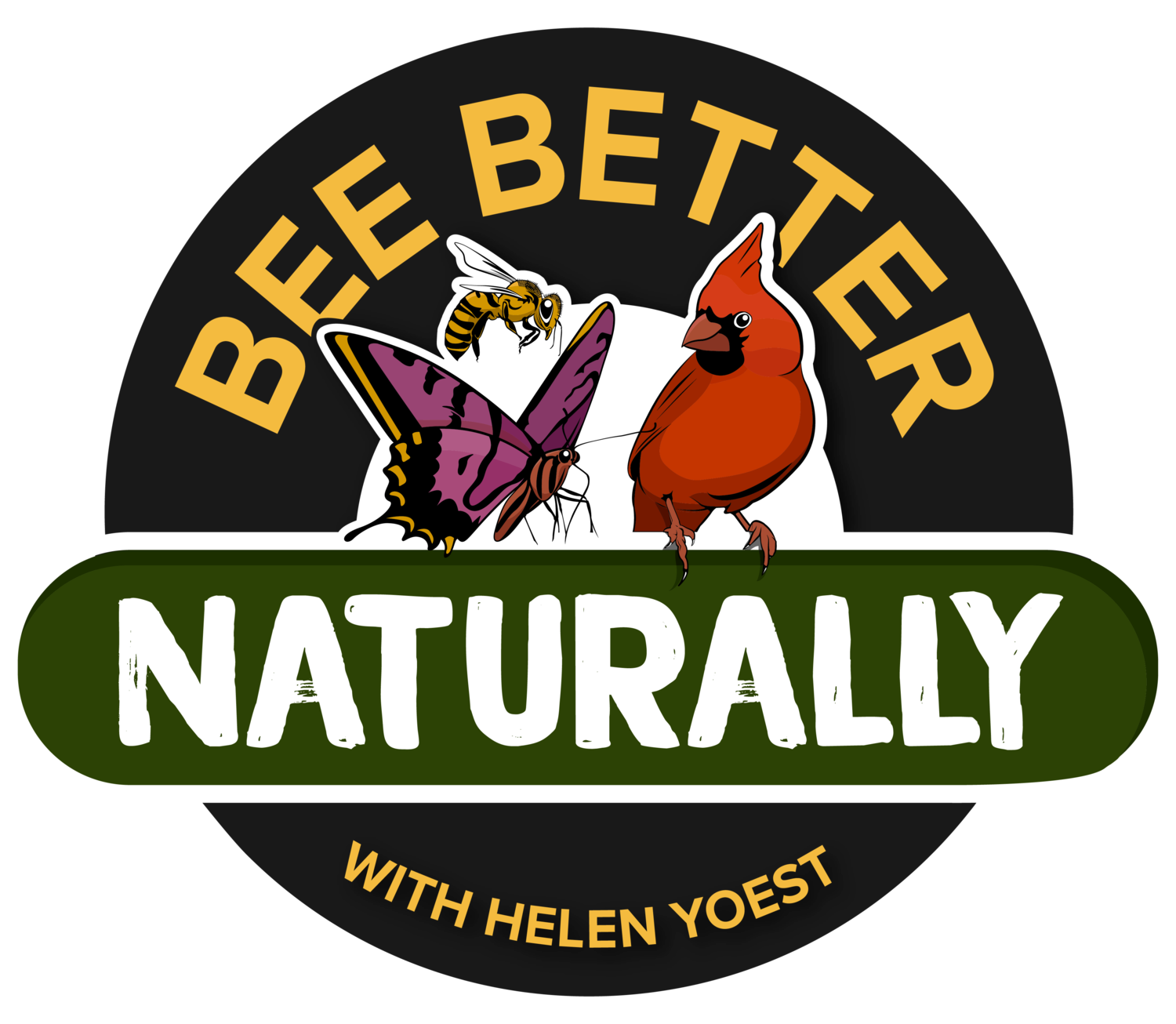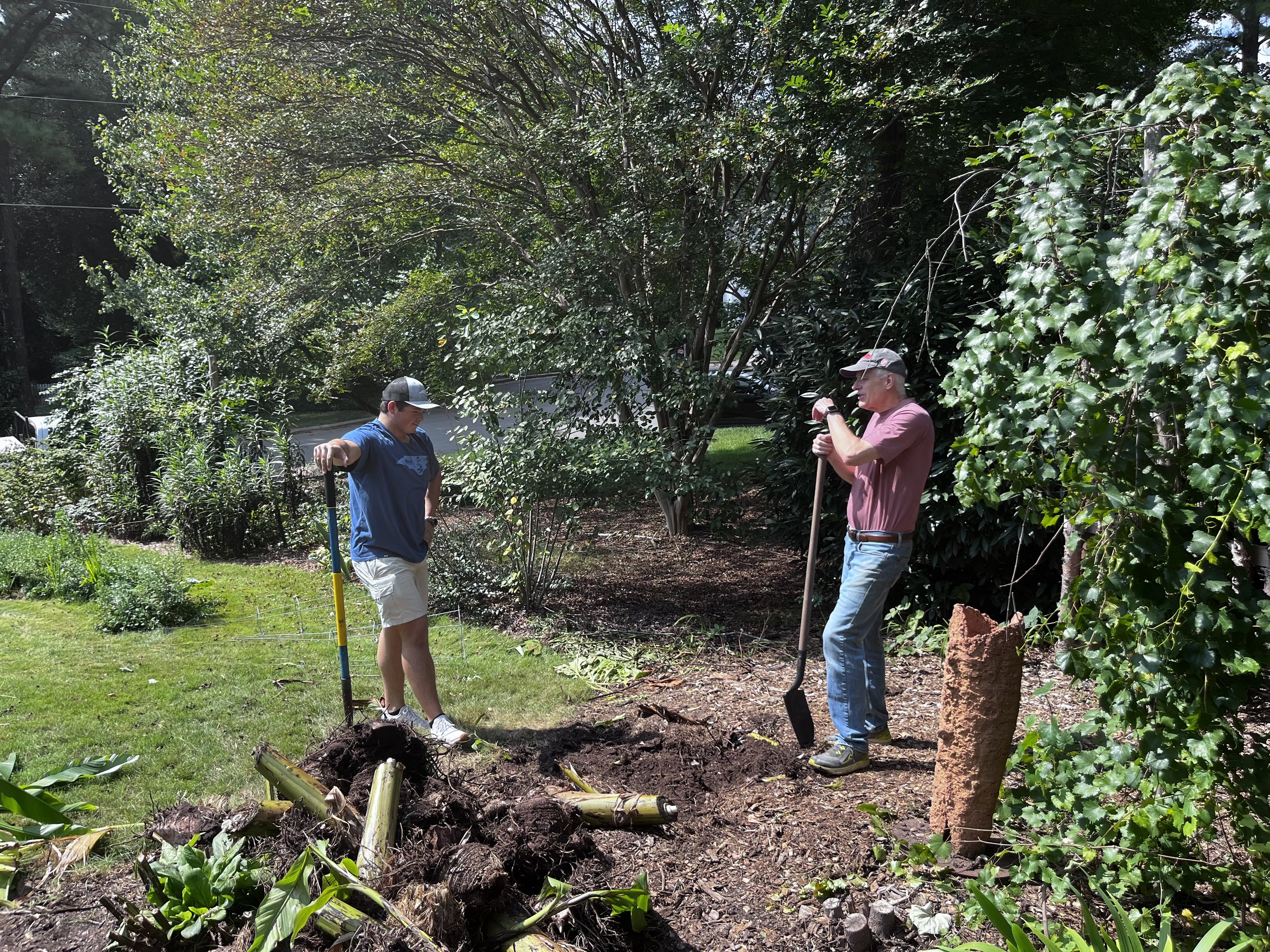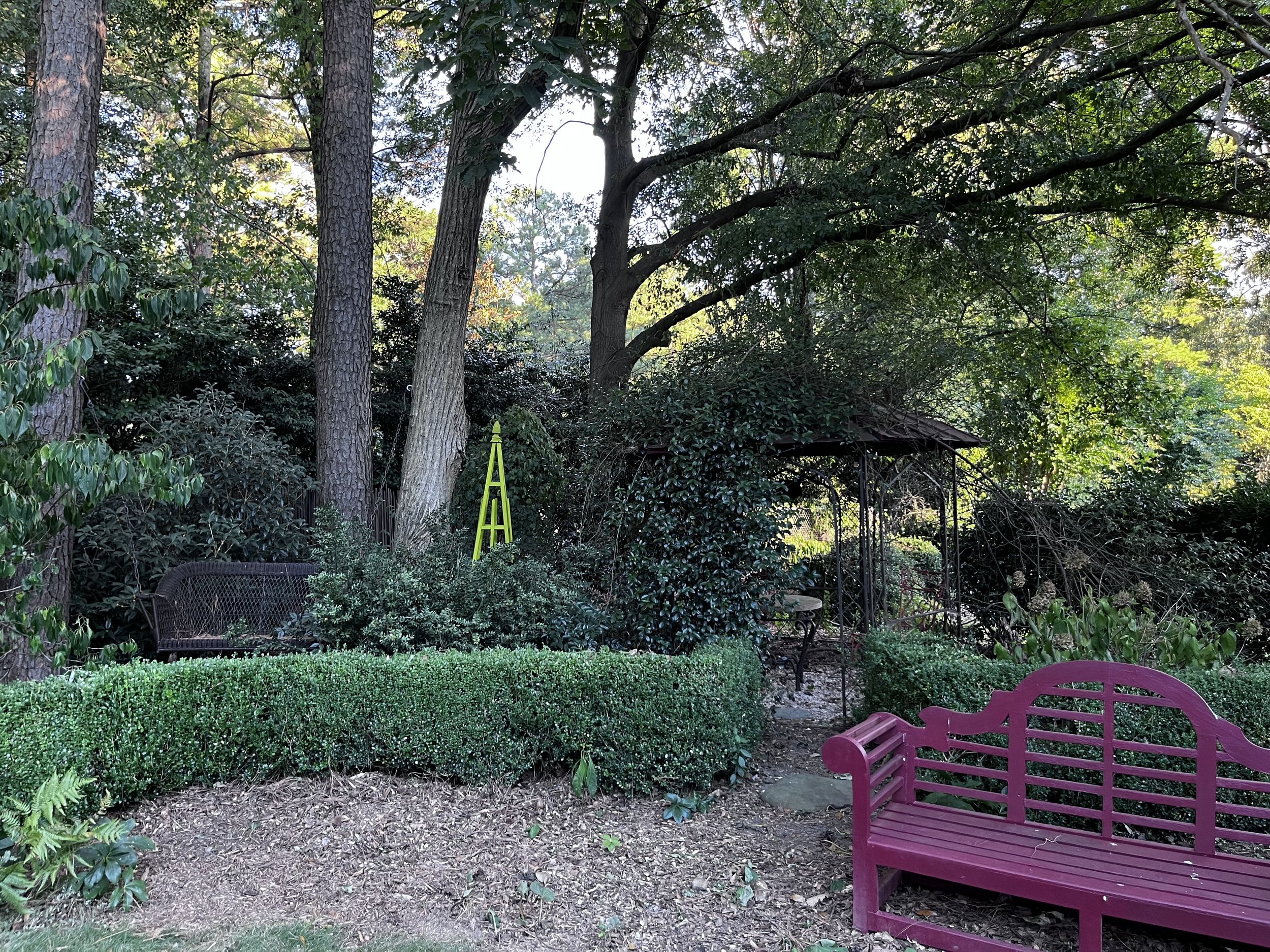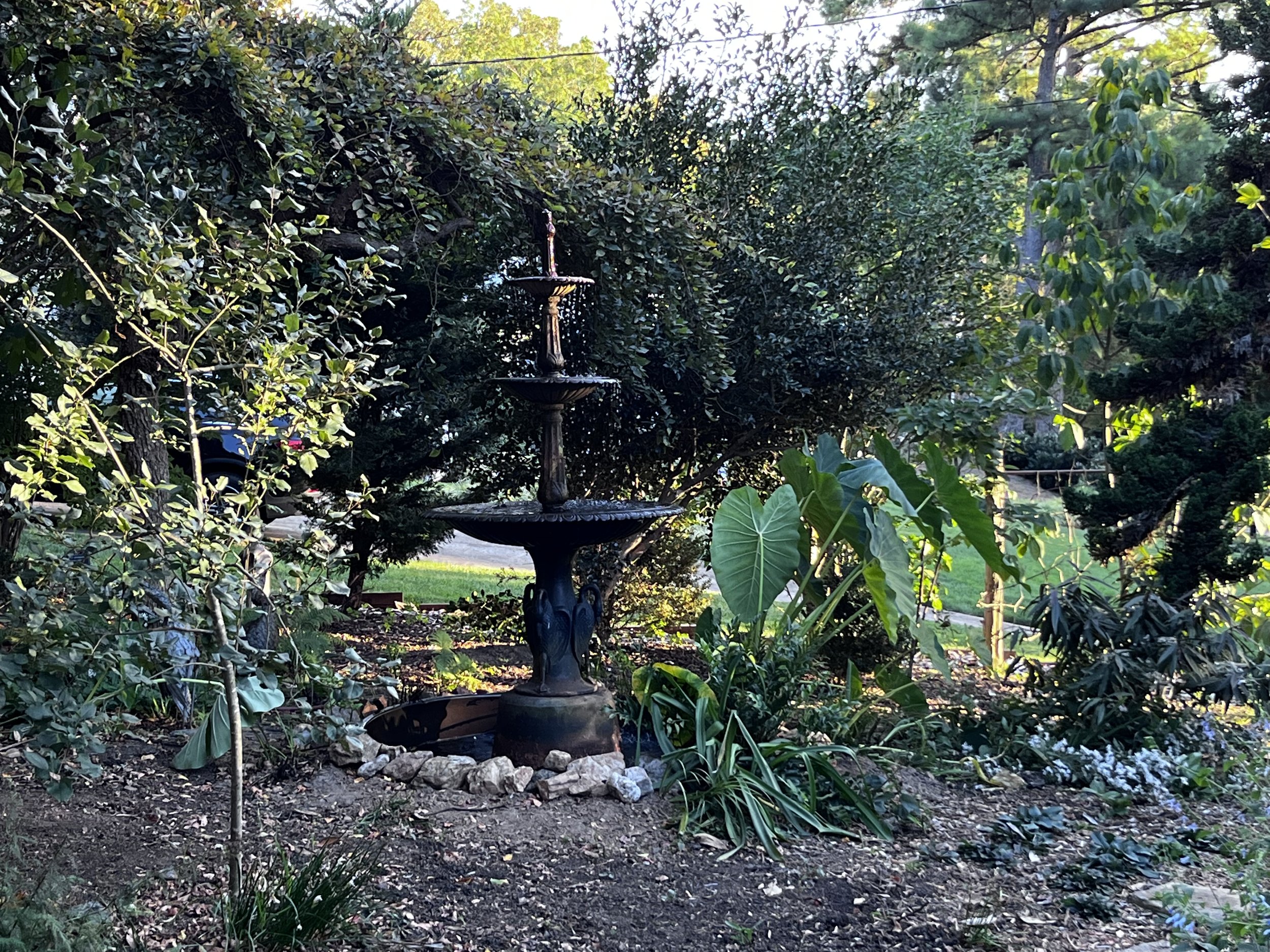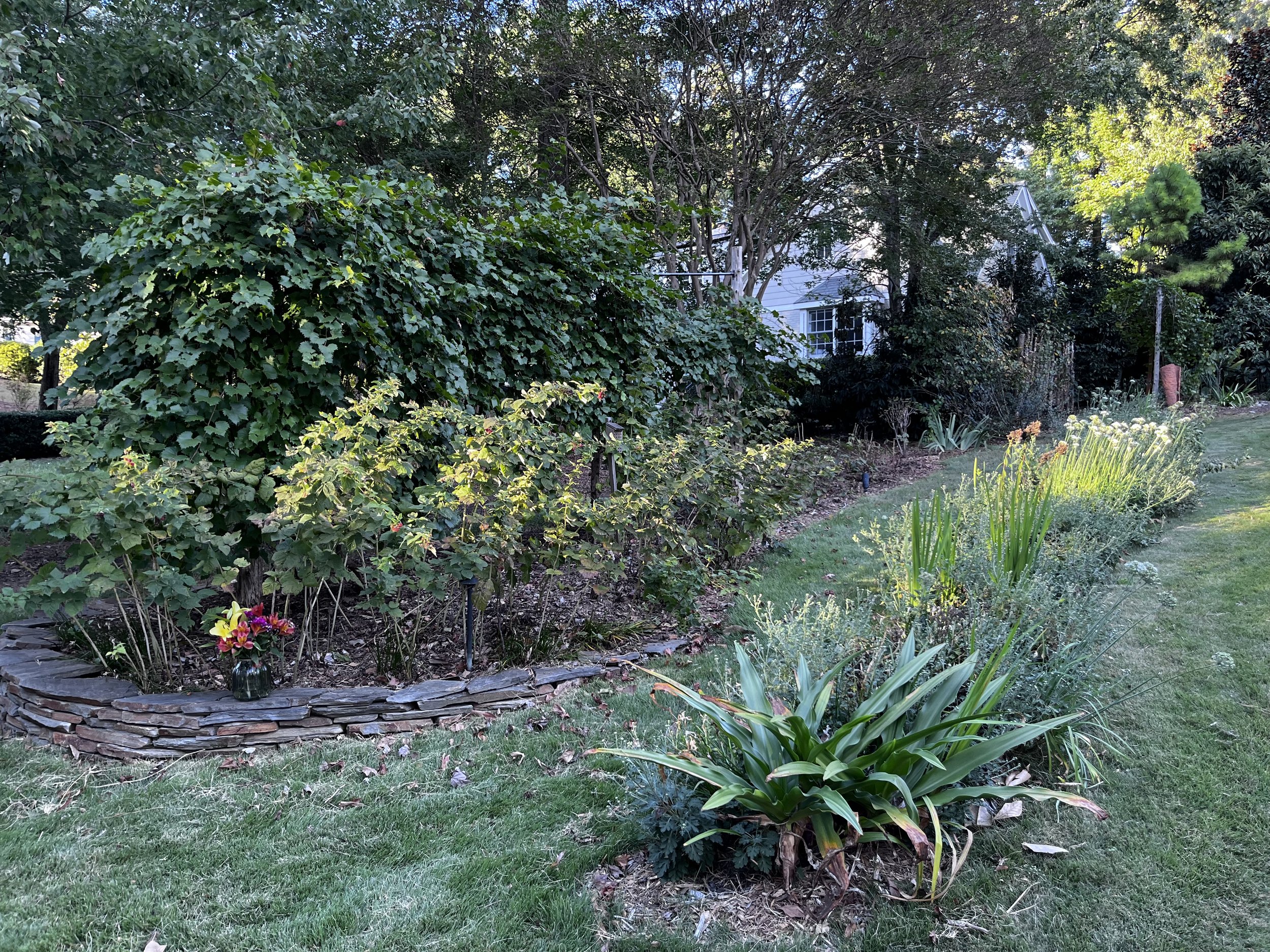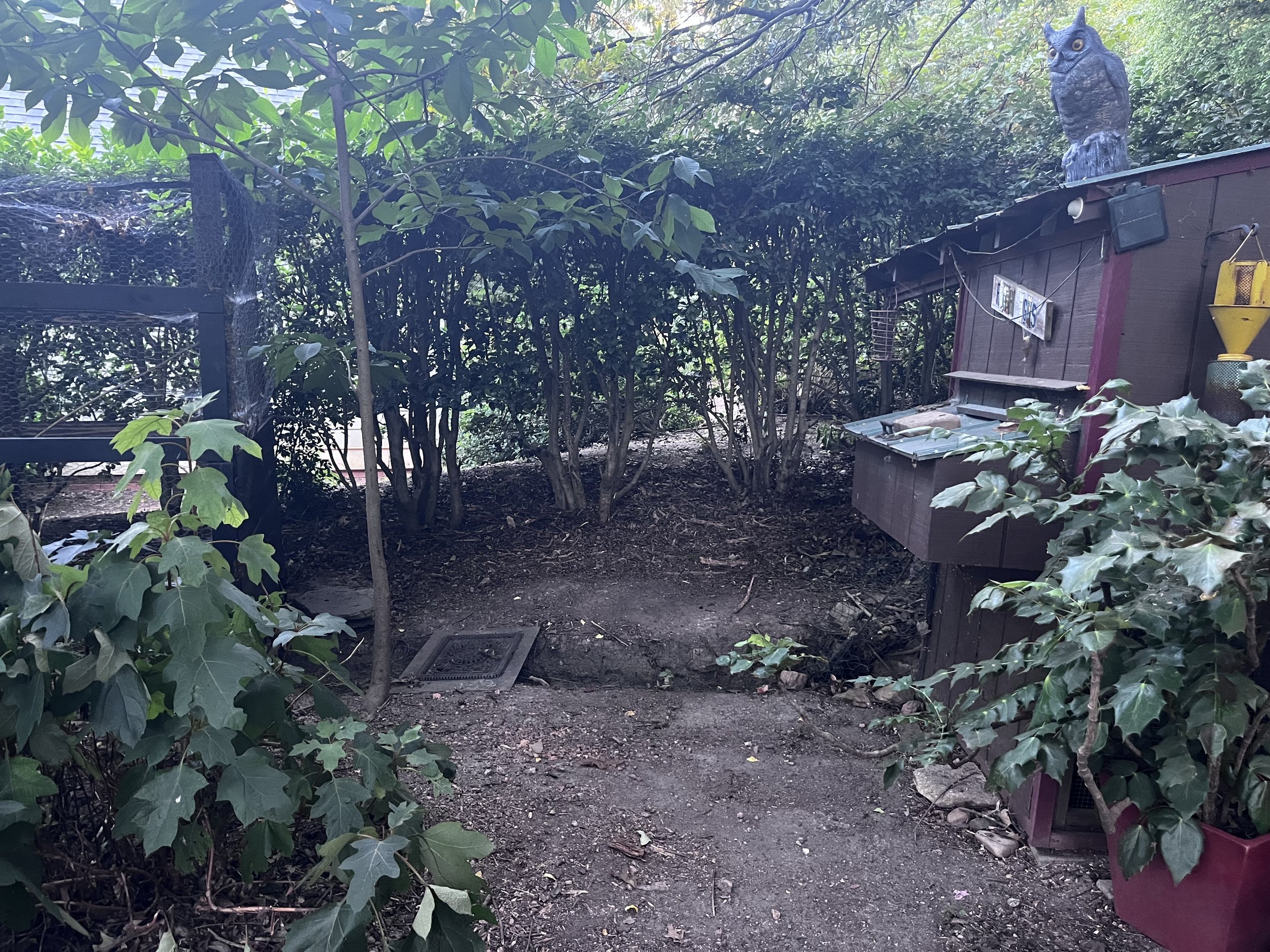Saying goodbye to September is never easy. Now I want time to sand still! Oops, “sand” was a typo, It was supposed to say STAND, but I think sand is appropriate.
With medical issues and the beach calling, there are things I can’t (or won’t want to) do anymore, and I want to travel and spend more time at the beach. No chance I’ll give up gardening, but I’m enhancing my focus, particularly out front.
I found myself renovating the front garden with the help of my daughter, Lara Rose. Nothing drastic, but my fruits are doing so well that I want more. The front is where I get the most sun. I still have plenty of life in me, but enhancing my focus will result in less maintenance.
In mid-September, I removed the banana trees. They were stunning, but each year I have to fell these trees and deadleaf the foliage to keep things looking tidy. And since I don’t use the leaves for cooking as I once did, I thought it best to take this maintenance away. When I say I removed them, I cut them, chopped them up, and asked for help. As my friend Jere says, I no longer stay no. We both say no to doing more, but if someone asks if they can help, we say yes! What I like is not so much to get the help but to get it over faster. Fall is my favorite season, and I want to live it!
It was a big job and even tasking for these two muscle men, Michael Aster and David. Knowing this makes the decision even more important. I promised I would only ask for help with something they would not have to help me in the future. Note: Up to this point, I’ve never asked for help, and I wouldn’t have this time if I wasn’t making room in the garden for more fruit-producing plants.
I’ve been a fruit grower for more than 15 years. That may seem like a long time, but I’m just reaching the production age for many fruits. I will continue with this focus for the next 10+; I never thought having a purely ornamental tree made sense when you can have a fruit-bearing tree with many of the same qualities made sense, so I’m making more room for food. I know I’m adding another fig I picked up at the JCRA plant sale. This will be my fifth variety. Id lo love figs!
Nothing to do with fruits, but I also cleared out the fountain and deadleafing surrounding plants. I was surprised at how much erosion there was around the reservoir. The good news? We had a lot of dirt, more than we needed, from the Joslin Garden. I opened up to everyone in the City and volunteers, and we hardly made a dent! I will take some more to fill holes left behind from digging out front ornamentals.
The Back 40 (ft) North to South. This area is now officially full of yard waste cuttings; not all, but a lot. When cutting the boxwoods, the tops were racked back, and the back could remain where they fell. This same a lot of labor!
The Back 40 (ft) South to North. We are starting to see chestnuts on the ground.
Gazebo Corner. This area needs some cleaning up, but I’ll wait until all the chestnuts fall.
The Epimedium Patch. The rabbits ate the epimedium x rubrum as soon as there were planted. Fingers crossed, the roots will shoot up in the fall. The voodoo lily, Amorphophallus konjac, are still looking good.
The Wildflower Patch. Once the fountain was removed, I began adding lots of wildflowers, particular wild gingers and more trilliums. It was still looking bear, so I’m making it into a miniature stumpery. It’s getting there but it will be another year or so before it’s super cute.
The Wildflower Patch Extension. This area filled with purple shamrock this summer. I like this plant, but I also have more interesting plants, particular Trillium spp. This October or November, I’ll more the shamrock to make room for showier plants.
Mixed Border, South to North. After the fair, I will be adding many of the pollinator plants used there to this bed.
The Southside. I was excited to finally get fruit! It took 10 plus years! The birds really liked the fruit!
The Ostrich Fern Garden. This is looking good. By next year, it will rock!
The Front Fountain Garden. Made great progress clearing plantings in the reservoir and trimming plants around the base. This was when I found all the erosion. I knew it had occurred but didn’t realize just how much. fortunately, we had 6 cubic yards of good dirt left over from the project at the Joslin Garden. That was when the light bulb went off! I backfilled the fount, at about eight inches deep, then added rock around the base and only mixing in a few plants. I had the stones around; it was a no-brainer. I’m happy with how it turned out.
The Food Forest, A lot went on here at the end of September. The path through the garden was widened; I removed the beautiful Carolina allspice, Calycanthus raulstonii 'Hartlage Wine,’ and would you believe pawpaw, Asimina triloba? The garden supports two others in the same area and another in the back. This is more than enough. I wanted more variety. Now I need to figure out what to put in my new space!
Parterre. The annuals here will be replaced this month. I’m thinking snapdragons.
The Raspberry/Scuppernongs Patch. I was busy here! The raspberries co-mingled with the scuppernongs. Scuppernongs are a native American grape, Vitis rotundifolia, found in the southeastern and south-central U.S. Did you know scuppernongs are a variety of muscadine? In other words, all scuppernongs are muscadines, but not all muscadines are scuppernongs.
Male and female scuppernongs are bronze or golden. Male and female muscadines are purple or black. However, a scuppernong is a muscadine. So, a golden colored muscadine is called a scuppernong. Muscadines are a variety of scuppernong. My husband recently made jelly out of out scuppernong; it turned out to be the best jelly ever. He did say, because of the seeds, it was especially difficult.
The Food Forest Extension. This area is already looking good.
The Asparagus Patch. Asparagus don’t like root competition. The boxwoods may be a problem. I cleared out all other plants and will add more asparagus, and see if that helps
The Blueberry Patch with Chimney Swift Tower. In October, I plan to work in this area more. The trellis staking the blackberries got tilty; and I need to cut back the vines.
The Pollinator Garden. Yellowjackets found a home in the Pollinator Garden, and then they found me. Yellowjacket is the common name in North America for predatory social wasps of the genera Vespula and Dolichovespula. Their nest was near the bananas, and once they were gone, I started working the soil. I didn’t see them coming. With my hat on, they flew under my hat and had a heyday. I got sung six times; my face was distorted for 36 hours! Just so happy, they didn’t get INTO my mouth.
The North Side. I moved several Acanthus spp. from the front to fill in the the side where there is an alée.
Rock Garden. I’ll weed this month.
The Girl’s Garden. I cleared half of the stick pile to neaten things up. Behind the coop, is the other half; providing protection without being an eyesore.
The Wildlife Pond I learned of a black waterproof glue that I’ll use to secure rocks along the edge.
Mixed Border, North to South
To read more of my writings, click HERE!
SCROLL TO THE END TO SEE WHAT’S IN BLOOM!
Have a Gardening Need? HIRE HELEN!
SUSTAINABLE GARDENING STEWARDSHIP:
There are many definitions of sustainable gardening, and through my decades as a sustainable gardener, I’ve summed it up to mean…wait for it…a garden that sustains itself and the life within! By that I mean, doing less, so much less, that it can take away the stress and much of the labor, bringing back the joy of gardening and bettering the environment.
Sustainable gardening is a concept of using gardening practices that cause no harm to the Earth and its inhabitants while working in a way to enhance it. But there’s more. To me, sustainable gardening is to have within all the aspects to sustain life. For example, to have a butterfly garden, it’s not enough to just have pretty nectar-rich flowers. For a butterfly garden to be fully sustainable, plants are required to sustain all aspects of the butterfly’s life cycle. That means providing host plants, specific plants that area butterflies need to lay their eggs. So yes, you will have holes in your leaves; that’s the goal!
Simply put, sustainable gardening is designing your garden to sustain itself and allows us to secure our future to make the Earth better than we found it. Think of it as organic gardening taken a step further.
Design becomes an important aspect for a garden to sustain itself, as well as providing the plants necessary to fully sustain wildlife in all respects of their lifecycle. You could just plant plants that are regionally native and provide exactly what nature does. No supplemental water, no cutbacks, no added mulch, and no pesticides or herbicide. Yet, many want more from their gardens, so we add plant diversity. What is key is the placement of these plants.
SOIL
FERTILIZING SUSTAINABLY
WATERING SUSTAINABLY
WATERWISE
WILDLIFE
CREATING A WILDLIFE HABITAT AT HOME
FOOD:
Our bird friends don’t need supplemental feed if you have a diverse garden. but we begin to heat up, keep up the feeder so you can watch your feathered friends from the inside of the home..
One of the best all-around seeds for birds is the black-oil sunflower. This seed has a high meat-to-shell ratio, it is high in fat, and it is sized perfectly for many seed eaters, including black-capped chickadees, cardinals, mourning doves, finches, juncos, jays, woodpeckers, and sparrows.
COVER:
Wildlife welcomes cover, year-round.
WATER:
As the berries in our area ripen, the birds are having a feast. Keep your birdbaths filled with freshwater, changing out at least every four days to break the mosquito larvae cycle.
PLACES TO RAISE THEIR YOUNG:
Plant diversity is key!
BIRDCARE:
Do you deadhead? Click HERE to learn more.
Check out this really nice bird identification and preferred foods for each bird from The Cornell Lab! Click HERE!
Are you familiar with how we can bring the birds back? Click HERE for starters.
As long as you are enjoying seeing the birds from your window, continue to Feed The Birds!
I also fill wire suet cages with native grasses.
HUMMINGBIRD UPDATE:
Female hummingbirds will be leaving soon, if not already.. To learn how to attract hummingbirds to your garden, click HERE.
INVASIVE PLANTS:
Invasive Plants:
By definition, did you know there is a different meaning between invasive plants vs. aggressive plants? A simple definition, invasive plants are introduced species, not native to our area, and show a tendency to spread out of control. Aggressive plants are those native to our area, and some can easily take over. We in. The Bee Better Teaching Garden keep an eye on both!
Clover
We don’t all think of clover as a weed. I certainly don’t! Do you think white clover is a weed? Think again. if you are one of the ones who want it gone in your turf, click HERE.
You may know pokeweed as American pokeweed, poke sallet, or dragonberries. All parts of the plant are poisonous, except when the foliage is about the height of a spread hand. Then it can be boiled with two water changes and eaten like cooked spinach.
The berries are highly desired by birds in the fall, and this helps the spread of pokeweed as they drop the seeds—everywhere! After consuming the berry, the seeds are spread by birds and frequently are found around the driplines of trees, shrubs, and along fencerows, and a massive amount around the plant.
If left too big, they can be hard to remove since they have a deep taproot. Try to note and remove seedlings early for an easier pull.
Pokeweed shoots can be composted in cold piles if berries are not present. Roots should not be added to cold piles, either. We cold compost in the Bee Better Naturally Teaching Garden. Cold composting is essentially letting a pile build and decompose.. It requires less effort from the gardener, yet the decomposition takes substantially longer—a year or more. We have a designated area behind some shrubs where we pile our biomass to slowly break down.
I thought you might be interested in learning how the dreaded Bradford pear had its beginning.
Creeping Charlie, Glechoma hederacea
Greenbriar, Smilax rotundifolia
Marsh Pennywort, Hydrocotyle sibthorpioides
GOOD BUGS:
Mysteries of the Dragonfly and Damselfly
BUTTERFLY UPDATE:
I’ve seen a few, but this oh-so-nice spring, they are slow to arrive full force. Recently, I registered the Bee Better Teaching Garden with the Rosalynn Carter Butterfly Trail. Have you looked into this?
We offer Caterpillar Support to those who are in need of butterfly caterpillars rescued. If you have butterfly caterpillars and are running out of host plants, or if you don’t want your plant defoliated, just email me at helenyoest at gmail.com. We can arrange for you to drop them off, and I will raise and release them.
Host Butterfly Plants
Bronze fennel is the host butterfly plant for the Eastern black swallowtail butterfly. The caterpillars feed on the fennel until time for the metamorphosis.
In our area, we don’t tend to see Eastern black swallowtails until a little later in the summer. But they will come. It’s not too late to plant their host plants. While they like fennel best, the caterpillars will also feed on curly parsley, dill, and carrot tops. To purchase the full list of host plants for butterflies within our Raleigh and Ecosystem 231, click HERE.
MONARCH UPDATE:
It is possible to see monarchs in the Raleigh area in the early summer, but we are more likely to see a bunch of them in the fall as they migrate south again. Have you planted your milkweed?
CHECK OUT Bee Better Naturally’s HOW-TOS!
CHECK OUT our SHOP/WORKSHOPS!
SPECIFICALLY…
CAMELLIAS
LAWNS
ROSES
TREES: Check out the latest advice from Leaf & Limb!
Why Dead Wood is Good Wood!
The Art of Espalier
SHRUBS:
The best time to prune flowering shrubs is right after they bloom.
ANNUALS:
I don’t tend to plant annuals, but I’m big on direct sowing. Zinnia’s are my go-to seeds. There are tall ones, shorter ones, and even ground cover types. Some look like show mums, others like pinwheels, and those that like daisies you will want to pluck to see if you if your love loves you.
PERENNIALS:
Rohdea japonica is sending up new shoots. Now is a good time to cut back old leaves. Same with the cast-iron plant, Aspidistra elatior. Cut back dead leaves to welcome fresh foliage.
BULBS:
Divide irises: Did you have success with your new iris planted this year or in the fall? If not, it could be due to several factors: too much shade, too much fertilizer, too deep a planting, or crowding. Now is a good time to correct any of these problems by lifting and relocating or repositioning to a more favorable location.
Plant the iris high with the rhizomes along the surface of the dirt. They can be covered finely and lightly with mulch, but not soil. Make sure you can either see the rhizomes or have the ability to brush away the mulch exposing the root. With the exception of the Louisiana variety, irises need six- to eight- hours of sunlight to bloom and require good drainage. If you have a damp, partial sun location in your garden, plant a Louisiana iris.
Camellias
Caladiums
VINES:
Virginia creeper, Parthenocissus quinquefolia. I find most people absolutely hate Virginia Creeper for the aggressiveness. I happen to find it extremely beneficial for birds in the fall. Did you know Virginia Creeper is a native?
Unfortunately, too many gardeners confuse it with poison ivy, Toxicodendron radicans, which is also a native and feeds birds. I get it. I’m highly allergic to poison ivy and have eradicated it from my property. I remember when I did so, I wasn’t allergic before but became so during its removal. The good/bad news was I did it all in one day, so I was affected even before the symptoms showed up! Otherwise, I may have stopped short of getting rid of it all, and being fearful my entire life in the garden! I had a rash from head to toe!!! It was then, in 1997, that I started wearing long sleeves and pants whenever gardening.
Crossvine, Bignonia capreolata; Lady Banks rose, Rosa banksiae; Carolina jessamine, Gelsemium sempervirens.
POND:
EDIBLE FOODS and FOOD FOREST:
Bee Better Teaching Garden grows at least 30 different fruits. Learn about our Food Forest HERE!
HERBS:
What’s looking good now in the Bee Better Teaching Garden:
Parsley, Petroselinum crispum-
Rue, Ruta graveolens
Thyme, Thymus vulgaris
Oregano, Origanum vulgare
Rosemary, Salvia rosmarinus, formally Rosmarinus Officinalis.
In the Food Forest, the rosemary has spider mites.
Without looking at this plant with a hand lens, it’s impossible to be sure, but this type of mottled leaves is typical of the damage done by either a sucking insect or spider mites. The leaves ended up stippled and paled with such infestations because the insect or mite pierce the leaf repeatedly as they feed, which kills the cells in the leaf. Initially, the leaves look stippled, but over time the entire leaf can die.
Leafhoppers, lacewings, and whitefly are three insects that suck plant juices and cause similar damage. If you look closely, or with a hand lens, and see webs, it’s likely spider mites are the cause.
Since most people want to eat their herbs, you, of course, don’t want to use systemic or other chemical insecticides. Also, mites aren’t killed by some insecticides. You could use one of the insecticide/miticides made from neem or cinnamon, however. Another good practice in such situations is to spray the plant with a hard stream of water once a week.
PERENNIALS:
Salvias
Foxgloves
Phlox
CHICKENS:
It’s that time of year when the girl’s laying slows down. Last week, I didn’t even get a dozen. I collected eight eggs to give to a friend on Thursday afternoon. Three days later when we got back, there were only three. We currently have seven girls.
SNAKES: Wondering what snake is in your backyard? Click HERE for an easy id.
Glossary
Until soon,
Helen
#WeCanAllBeeBetter!
